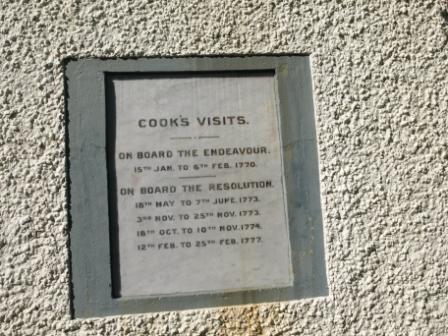Ship Cove

VulcanSpirit
Richard & Alison Brunstrom
Thu 11 Apr 2013 10:03
|
We've taken an interest in the voyages of Captain
James Cook as we crossed the Pacific, and we've followed it up here. Abel Tasman
was the first European to sight NZ in 1642, but a brush with unfriendly Maoris
saw him off without landing. The next European visitor was Cook in 1769. Cook
made five visits to NZ, repeatedly returning to Ship Cove in Queen Charlotte
Sound (named by Cook after the wife of George the Third), his favourite Pacific
anchorage.
Ship Cove is on the northern tip of South island,
near the entrance to the Sound. Here it is, seen from Motuara Island which
protects the Cove from the ocean swell:
 The NZ government has done rather a good job,
deliberately, in keeping the Cove looking as close as possible to its appearance
during Cook's time - albeit tragically with a lot fewer birds. Ship Cove is one
of very few shallow protected anchorages in the Sounds (which are drowned river
valleys); even better it has a careenage. This is it:
 "A what?", I hear you ask. A careenage is a place
where you may careen a ship. You beach your ship at high tide having previously
lightened it by removing as much from it as possible to reduce its draught. Then
you pull it onto its side by a rope to the top of a mast, exposing its bottom
which you may now scrub clean (careen) to remove the massive amount of marine
growth that has accumulated there on your journey from Europe (no antifouling
paint in Cook's day!). This is a lovely careenage formed by the delta of a nice
little stream giving the added benefit of clean fresh water on
site.
There is a rather ugly memorial with some very good
interpretation hidden in the trees. A couple of old cannon were added to give a
naval flavour. One is early nineteenth century, the other is earlier. Recent
research has now proved that quite by coincidence it is actually one of
Cook's.
  A really delightful place with a very calm feel -
no houses, no road access (just a few foot ferries and a walking track). We
loved it.
And here is Motuara Island from near Ship Cove,
looking north towards North Island beneath the long cloud in the distance
across the Cook Strait. When Cook arrived in 1770 there was a Maori pa
(fortified village) on the small island to the right. For some reason, possibly
the pa (Ship Cove was uninhabited), Cook chose Motuara as the place to raise the
flag on 31 January 1770 and claim the entire country for King George, in
the presence of the (I expect rather bemused) village chief.
 The hillock on the right has a memorial to the
event; again of rather strange design. Presumably either Cook cut the trees down
on the hilltop to enable the flag to be raised, or the Maori living thre had
already done so. But nowadays its a rather special bird reserve, covered in
regenerating native bush.
 There are three species of penguin breeding in NZ.
The commonest, the Blue Penguin Eudypetula minor breeds all round the
NZ coast but is having great difficulty with stoat predation. Some idiot
introduced rabbits. They rapidly became a pest. So another idiot had the
brilliant idea of introducing stoats to eat the rabbits as they do in the UK.
But stoats would rather eat ground nesting birds (especially flightless ones),
their chicks and eggs. So they did. The effect on native birds has been
absolutely catastrophic. But Motuara has now been cleared of introduced
predators and the penguins breed and moult here. The island has a path, with
penguin boxes. Here is one. The lid opens, and inside is a penguin (not
photographed so as not to frighten him with the flash). This particular box is
right at the top of the island next to the memorial. The occupant climbs up
through the forest from the sea on those ridiculous little penguin legs every
morning, and then back down again every evening. There were lots of empty boxes
closer to the sea, but this guy likes the one at the top.
 And here, perched on the knee of a disembodied
member of the crew of Vulcan Spirit is a South Island Robin Petroica
australis, a rare bird now recovering with the help of predator-free
islands like Motuara. No relation to the European Robin but a very similar
engaging and inquisitive manner - they feed on ground dwelling creepy-crawlies
and really like you to drag your foot through the leaf litter to expose their
dinner - very reminiscent of a British Robin getting worms from the vegetable
gardener.
 Motuara is now alive with birdsong again unlike
much NZ native bush which is often rather sadly silent.
|